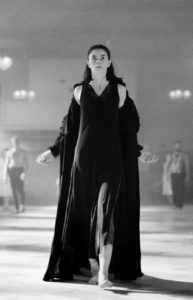Perth: Summer 2019 - Vancouver Ballet Society
- Home
- City Reports 2015 - 2019
- Perth: Summer 2019

By Rhys Ryan
While most of Australia’s dance scene lay dormant, Perth Festival took centre stage early in 2019 with an ambitious line-up of local and international works. It was the country’s largest and most diverse festival programming for dance in recent years, outdoing east coast counterparts in Sydney and Melbourne.
A festival headliner was Sunset, a new immersive dance-theatre work created by U.K. director and choreographer Maxine Doyle, best known for her co-direction of Punchdrunk’s Sleep No More. Over the past three years, Doyle has collaborated with Perth-based choreographic centre STRUT Dance to share her methodology with local independent dancers and ultimately stage Sunset as an original site-specific work for Australian audiences.
The site was Sunset Heritage Precinct on the banks of Perth’s Swan River, a sprawling collection of abandoned buildings originally built in 1904 as a care facility for elderly men and later used as a general hospital. The site oozes with character, and Doyle’s production dramatically reimagined the facility’s colourful history.
After being led through a warren of dimly lit rooms, the audience was free to roam through the main hall, encountering the performers at close range. We saw a nurse serving tea, a shaggy haired man in a drunken stupour and a youthful figure darting about covered in gold glitter. These peculiar characters — part historical, part mythological — formed the substance of the work.
Through a series of danced and spoken vignettes, we met the people who may have lived or worked at the men’s home. They performed ordinary acts of daily life — celebrating a birthday or reading a poem — before abruptly transitioning to an altered state of being, punctuated by dramatic or ecstatic movement. This oscillation spoke of restlessness, a kind of existential limbo that a place like Sunset so readily provoked.
The ensemble cast comprised a dozen local dancers and actors who each embodied their character with conviction, developing an idiosyncratic and mesmerizing movement vocabulary. Doyle’s skill in bringing together performance, design, lighting and sound to activate the dormant building was impressive and compelling.
Dimitris Papaioannou’s The Great Tamer visited Perth Festival as part of its current international tour. The Greek director, who trained as a painter and whose credits include the 2004 Athens Olympic Ceremonies, offered an inner excavation for meaning through a collage of unadorned choreography, poignant symbolism and brilliant design.
In a literal sense, the stage itself was an excavation site. Dozens of black plywood sheets formed a sloped embankment, many of which were tossed aside or ripped up to uncover a world below. The performers (or sometimes just their naked limbs) frequently entered and exited the space through the floor in sequences reminiscent of a grotesque birthing.
Above ground, the bodies played out a series of peculiar vignettes that seemed to disassemble and reconstruct the body limb by limb. These choreographic illustrations were at once macabre and beautiful. To counter the bleak tableaux, humour was littered throughout the work in typical Greek style. There were also moments of extraordinary intimacy, throwing up questions about our shared humanity and the violence we let pervade it.
The ensemble cast was exceptionally talented and understood the work’s dramatic subtleties. Through breathtaking visual design and ingenious choreography, The Great Tamer shattered then reconfigured one’s idea of unspoken storytelling.
West Australian Ballet’s annual contemporary season, In-Synch: Ballet at the Quarry, was a mixed program of four short works. Finnish choreographer Johanna Nuutinen’s X-It explored the paranoia of being under constant surveillance through surging and frenetic choreography. The dancers interacted with digital versions of themselves on a large screen, moving in unison, rebelling against their avatars or disappearing “into” the screen. It was a slick affair and well danced, but a dated and uninspiring score, and a few too many compositional ideas held the work back.
The evening’s highlight, Reincarnation, was an eccentric new work about rebirth and transformation by Australian Dance Theatre artistic director Garry Stewart. Angularity and rhythm shaped the choreography, which saw trios and quartets emerge and dissolve into longer passages of crisp ensemble unison.
Guest dancers from local contemporary outfit Co3 Australia were in their comfort zone with Stewart’s signature high-octane and aggressive choreography, and the classically trained dancers integrated fairly seamlessly. Reincarnation, however, lacked colour and shade and, without much thematic or choreographic variation, it felt a little long.
The rest of the program featured a mostly improvised and underwhelming in-house work, In-Synch, plus a very dated remount of the 1996 slapstick ballet The Sofa by Israeli choreographer Itzik Galili. Although West Australian Ballet’s contemporary technique was commendable, the program as a whole lacked sophistication and failed to impress.
The rest of Perth Festival featured two notable international collaborations: Kwongkan by Australia’s Ochre Contemporary Dance Company and India’s Daksha Sheth Dance Company, and One Infinity choreographed by Gideon Obarzanek in collaboration with Dancenorth Australia and Beijing Dance Theater. Radical reinterpretations of story ballets were a festival theme, with audiences given the opportunity to see Giselle by Dada Masilo (South Africa) and Swan Lake by Michael Keegan-Dolan’s new company Teac Damsa (Ireland).

